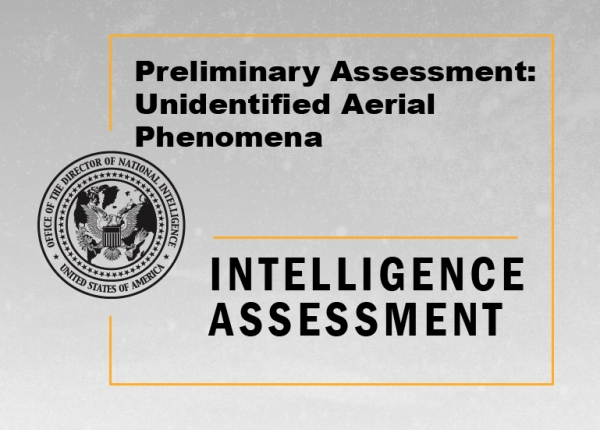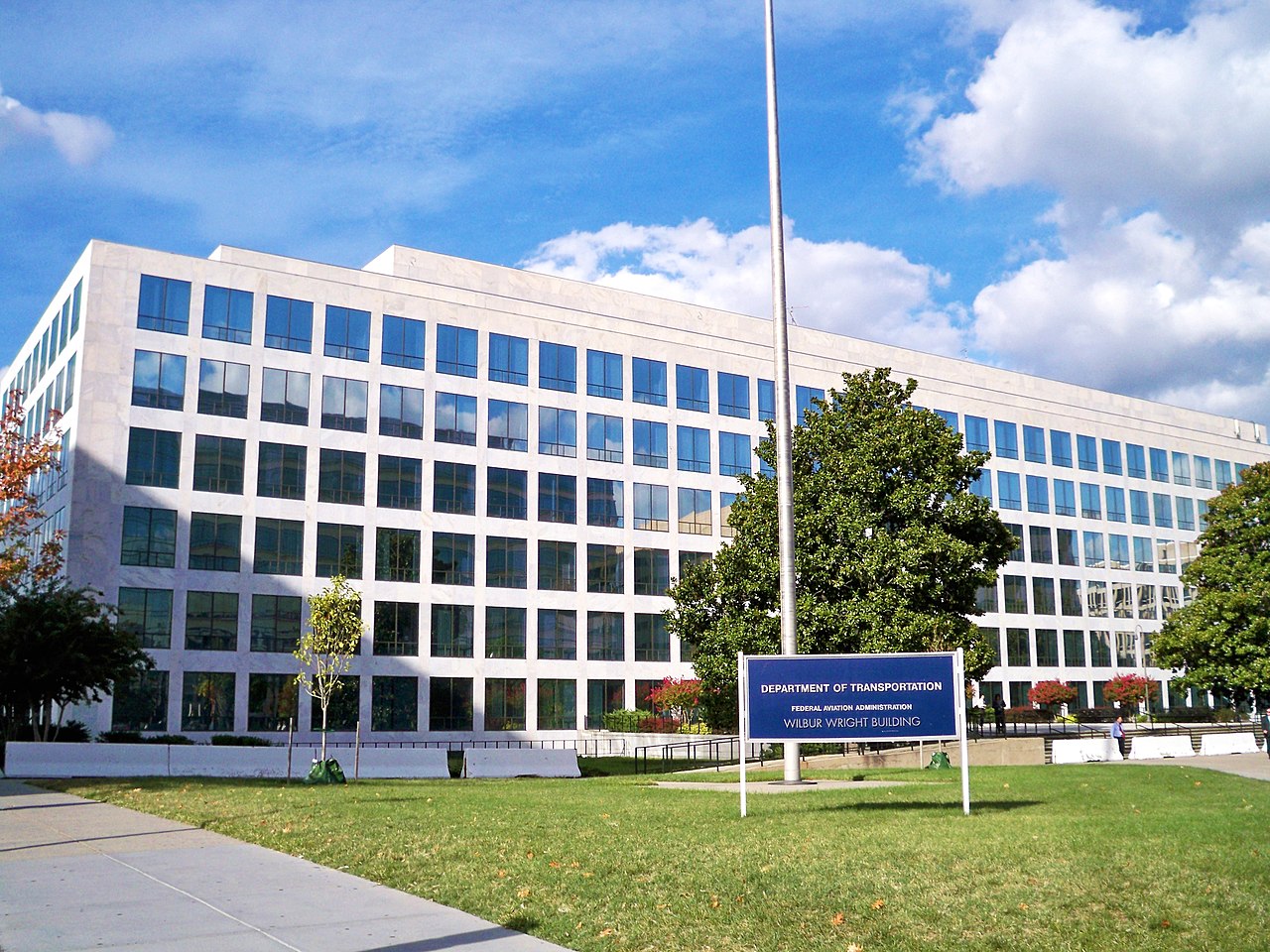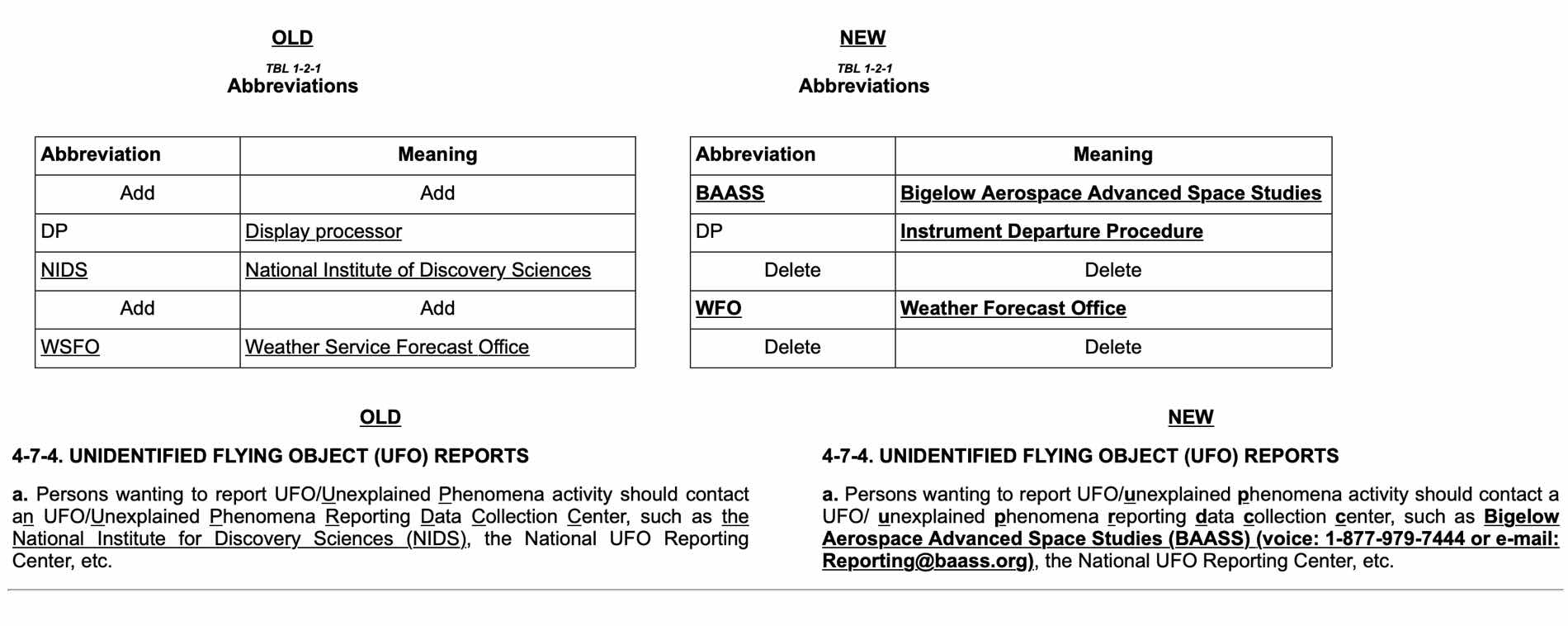
With the arrival of an eagerly awaited preliminary assessment on unidentified aerial phenomena by the Navy’s UAP Task Force in June, opinions on its findings were mixed and varied.
Of greater significance than the contents of the report, perhaps, had been what it left out. Nowhere in the nine-page document delivered to the Office of the Director of National Intelligence (ODNI) did words like “extraterrestrial” or “alien” make an appearance, a reality that was no doubt received with much frustration by longtime proponents of the existence of unusual aerial phenomena.
This, despite hopeful pre-reporting by the New York Times, who promised that officials who had been briefed on a classified version of the report prior to its debut “conceded that the very ambiguity of the findings” meant that more exotic potentials couldn’t be ruled out. This seemingly left open for the possibility “that the phenomena observed by military pilots might be alien spacecraft.”To date, there remains nothing conclusive that links observations of unidentified aerial phenomena—or what until recent years were commonly referred to simply as UFOs—with extraterrestrial technologies. While many hopeful proponents of such speculations on the origin of UAP were likely irritated by the report’s ambiguous tone, the document did reveal a few notable surprises.

“The UAPTF is currently working to acquire additional reporting,” one portion of the report reads, “including from the U.S. Air Force (USAF), and has begun receiving data from the Federal Aviation Administration (FAA).”
The inclusion of the FAA as a source for information about UAP within the document was notable, especially because in years past, the agency tasked with regulating all civil aviation in the United States has seemed to want no involvement of any sort with unidentified flying objects.
FAA Order JO 7110.65Z – Air Traffic Control, a publication that “prescribes air traffic control procedures and phraseology for use by personnel providing air traffic control services” took effect on June 17, 2021—just days prior to the delivery of the UAP Task Force’s preliminary report. In chapter nine of the order, dealing with “Special Flights”, section eight is titled “Unidentified Flying Object (UFO) Reports”, and outlines the following procedure for UFO sightings made by air traffic control personnel:
9-8-1. GENERAL
- Persons wanting to report UFO/unexplained phenomena activity should contact a UFO/ unexplained phenomena reporting data collection center, such as the National UFO Reporting Center, etc.
- If concern is expressed that life or property might be endangered, report the activity to the local law enforcement department.
Identical wording with regard to UFO observations by FAA Air Traffic Organization personnel appears in other publications by the agency, which includes Section 7 of FAA Order JO 7210.3CC – Facility Operation and Administration.
The UAP Task Force and the FAA
It therefore came as a surprise for many who read the recent ODNI report, with its inclusion of the following statement: “The FAA captures data related to UAP during the normal course of managing air traffic operations. The FAA generally ingests this data when pilots and other airspace users report unusual or unexpected events to the FAA’s Air Traffic Organization.”

The Wilbur Wright Federal Building, current location of FAA’s headquarters (Credit: Matthew G. Bisanz CC 3.0).
According to its own procedural publications cited above, the FAA appears to direct air traffic operators to report instances involving UAP (or UFOs, as the agency’s documentation still calls them) to civilian organizations like the Washington-based National UFO Reporting Center. These publications appear to provide no procedural details related to an internal system for collecting such data within the agency.
The fact that the FAA “captures data related to UAP” had not been the only pertinent information about the agency’s involvement with UAP studies included in the June report. Additionally, its authors state that “the FAA continuously monitors its systems for anomalies, generating additional information that may be of use to the UAPTF. The FAA is able to isolate data of interest to the UAPTF and make it available.”
“The FAA has a robust and effective outreach program that can help the UAPTF reach members of the aviation community to highlight the importance of reporting UAP,” the report also states.
“That may be news to the FAA,” Suzanne Rowan Kelleher reported in a Forbes article in June, adding that she was told the “agency that operates air traffic control and navigation for both civil and military aircraft insists it does not deal directly with UAP sightings from commercial pilots.”
“The FAA doesn’t track these reports,” Kelleher quoted an FAA spokesperson as having said, who told her that “The National UFO Reporting Center is your best source.”
Similarly, David Axe writing for The Daily Beast noted that “The FAA did not respond to a request for comment” regarding his inquiries about the agency’s UAP data collection described in the June ODNI report.
The FAA Finally Goes on the Record About UAP
In light of the specific references to the FAA and its apparent role in supporting the Navy’s UAP Task Force outlined in the ODNI report, The Debrief reached out to the agency for clarification, asking if it could confirm its role in the collection of UAP data. After several weeks of inquiries, the FAA finally responded to requests for clarification from The Debrief.
“The Federal Aviation Administration documents Unidentified Aerial Phenomenon (UAP) sightings whenever a pilot reports one to an air traffic control facility,” an FAA spokesperson told The Debrief in an email.
“If the pilot report can be corroborated with supporting information such as radar data, it is shared with the UAP Task Force,” the spokesperson added. The statement marks a notable shift from the FAA’s previous positions regarding UAP, and its insistence even in days following the release of the ODNI report that it has limited involvement with the collection of such data.
Earlier versions of the FAA’s JO 7110.65 order included the additional recommendation that UFO reports should be sent to agencies “such as Bigelow Aerospace Advanced Space Studies (BAASS),” with the inclusion of a phone number and email for contacting the organization.
According to an FAA briefing guide issued in February 2010, “Bigelow Aerospace Advanced Space Studies (BAASS) is a new organization that is devoted to exploration of extremely advanced aerospace technology, including the so-called unidentified aerial phenomena (UAP) or unidentified flying object (UFO) topics.”
ABOVE: Portion of a 2010 FAA briefing document outlining the replacement
of the National Institute for Discovery Science with Bigelow Aerospace
Advanced Space Studies as its recommended agency to contact for
reporting UFO sightings (Credit: FAA/Public Domain)
ABOVE: Portion of a 2010 FAA briefing document outlining the replacement
of the National Institute for Discovery Science with Bigelow Aerospace
Advanced Space Studies as its recommended agency to contact for
reporting UFO sightings (Credit: FAA/Public Domain)
The guide added that “In 2001, another of Mr. Bigelow’s organizations, the National Institute for Discovery Sciences (NIDS), succeeded in becoming the ‘go-to’ organization for the reporting by pilots and air traffic control of UFOs in the United States.”
“NIDS is now defunct and has been replaced by the larger, more capable BAASS,” the 2010 guide reads. “Therefore, pilot and air traffic control reporting of UFOs in the United States should now go to BAASS, vice NIDS. So we are deleting the NIDS acronym and adding the BAASS acronym.”
Robert Bigelow, the FAA, and UFOs
The story of how Bigelow Aerospace Advanced Space Studies (BAASS) and its predecessor, the National Institute for Discovery Science (NIDS), became recipients of UFO reports from the FAA–thereby freeing the FAA from having any direct involvement with UFOs for several years–can be traced back to retired United States Army colonel John B. Alexander, Ph.D. A longtime advocate for development of nonlethal weapons while in government, Alexander also worked for Robert Bigelow’s NIDS organization for a time. Speaking with Alexander, The Debrief asked about his role in arranging for the FAA to forward UFO reports it received to Bigelow’s organization.
“That is correct,” Alexander said. “This is one of those serendipitous events when I was first assigned to the Pentagon and living in northern Virginia.”

John B. Alexander, Ph.D., who while working with the National Institute
for Discovery Science helped arrange for the organization to receive UFO
sighting reports redirected from the FAA (Public Domain).
As Alexander explained, shortly after his assignment he had taken residence in an apartment building where “they had a Friday night happy hour kinda thing, and one of the other occupants happened to be the Deputy Director of Security for the FAA. So I knew him personally.”
“After 911,” Alexander told The Debrief, “[the FAA] became sacrificial lambs. I might mention the FAA had been screaming about security for years before that. The airlines had been resisting mightily.”
“So I went to Washington and had an initial conversation, and said look, we’re interested in [UAP],” Alexander says. Following this meeting, the FAA Deputy Director “was able to set up a secondary meeting where we had Bob [Bigelow] and Colm [Kelleher] with us. And we came in and met with some senior FAA officials.”
“Interestingly, the guys who had experience as air traffic controllers were pretty supportive,” Alexander said. “Many of them had experiences of reports coming in while they were on duty. Organizationally, they were just happy to have an outlet to make this go away.”
“Which, by the way, is the way this has happened across the board in many governmental agencies,” says Alexander.
In the mid 1980s, Alexander founded an informal group of government insiders interested in finding out whether there might be a black program within government that dealt with UFOs. Called the Advanced Theoretical Physics Project (ATPP), Alexander’s group included members from all three military branches and others from the aerospace and intelligence communities. A requirement for membership had been a Top Secret-SCI security clearance at SI-TK, so that all members “had appropriate clearances and could help disseminate information.”
Despite receiving a limited amount of support from many high-level officials during their search, the ATPP found no evidence of any existing black programs within government that were involved with UFOs. To the contrary, Alexander came away from the experience with the feeling that most agencies within government want as little to do with the subject as possible.

In March, Politico reported that several government agencies had allegedly been “blocking or simply ignoring the effort to catalog what they have on [UAP],” based on testimony from several past and present government officials with knowledge on the matter. Despite the aversion to releasing information on UAP shown by the intelligence community, it did not result in a postponement of the report’s delivery to the ODNI by its June 25 deadline, as some had suspected might occur.
“From what I understand,” Alexander says, “all those agencies listed [in the ODNI report] technically participated, but several were certainly dragging their feet, and this was not voluntary at all.”
“Most of them just don’t want anything to do with the topic,” Alexander says.
The FAA Flip Flops on UAP
Also in March, The Debrief reported on its investigation into UAP incidents found within the Aviation Safety Reporting System (ASRS), an online database maintained by NASA which collects anonymous reports on behalf of the FAA from pilots, air traffic control personnel, and others who observe potential aviation hazards.
“An ASRS report collects information on what the pilot saw or experienced,” an FAA spokesperson told The Debrief in response to requests for information about UAP incidents within the publicly searchable ASRS database.
“Unless a hazard is reported, information in an ASRS report is not investigated, and the accuracy of the information is not verified,” an FAA spokesperson told The Debrief.
In February, the FAA also acknowledged an incident involving a sighting of an unusual aerial object over New Mexico by the pilot of American Airlines flight 2292.

“A pilot reported seeing an object over New Mexico shortly after noon local time on Sunday, Feb. 21, 2021,” the FAA said in a statement following the incident. However, the agency added that “FAA air traffic controllers did not see any object in the area on their radarscopes,” and provided no additional information on the incident.
The FAA is likely to be one of several agencies tasked with having greater involvement with collecting data on UAP in recent days. It was reported by The Debrief on August 7 that the Navy’s UAP Task Force is expected to obtain greater access to information on UAP collected by U.S. intelligence agencies, according to provisions included within the recently passed Intelligence Authorization Act for Fiscal Year 2022 (IAA).
The Debrief also queried the FAA about what specific information on anomalous aerial phenomena the agency collects, its role with outreach programs that help to facilitate pilots reporting their UAP encounters, and whether the FAA’s documentation of incidents that it sends to the UAP Task Force conflicts with the agency’s own stated policies.
However, the FAA provided no further information in response to our questions about its documentation of UAP sightings or other operations in support of the Navy’s UAP Task Force.
Speaking with The Debrief about his past experience working with government agencies like the FAA in relation to UAP, John Alexander put it bluntly.
“UAP is basically seen as a pain in the ass,” he said, summarizing the prevailing attitude toward the subject as being one primarily of avoidance at all costs.
“Anything that gets it out of my bailiwick is a good thing,” Alexander said.
Micah Hanks
No comments:
Post a Comment
Note: Only a member of this blog may post a comment.